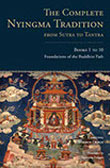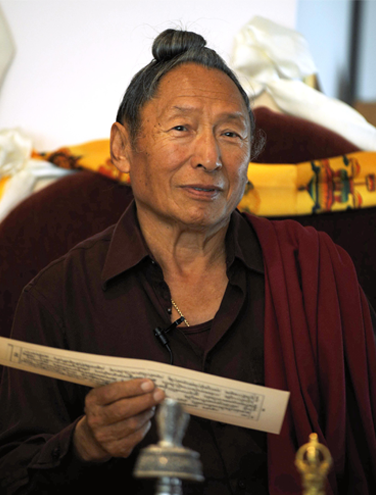The Complete Nyingma Tradition
From Sutra to Tantra
 In honor of Lama Tharchin Rinpoche and with deep appreciation for his extraordinary kindness and generosity to a generation of Western Buddhist students, Tsadra Foundation is delighted to bring to fruition his long held dream of making this seminal work available to English speaking students. Foundations of the Buddhist Path, translated by Ngawang Zangpo, comprising Books 1-10 appeared in June 2015. The Essential Tantras of Mahayoga, translated by Gyurme Dorje, comprising Books 15-17 appeared in 2016. Books 13 and 14 were published in 2017. Heidi Nevin is currently (2023) working on books 19 and 20. The remaining volumes 18-25 will follow.
In honor of Lama Tharchin Rinpoche and with deep appreciation for his extraordinary kindness and generosity to a generation of Western Buddhist students, Tsadra Foundation is delighted to bring to fruition his long held dream of making this seminal work available to English speaking students. Foundations of the Buddhist Path, translated by Ngawang Zangpo, comprising Books 1-10 appeared in June 2015. The Essential Tantras of Mahayoga, translated by Gyurme Dorje, comprising Books 15-17 appeared in 2016. Books 13 and 14 were published in 2017. Heidi Nevin is currently (2023) working on books 19 and 20. The remaining volumes 18-25 will follow.
The 25 volumes of The Complete Nyingma Tradition comprise:
- Book 1: Discipleship and forsaking misleading companions
- Book 2: How the sacred Buddhist doctrine is transmitted through teaching and listening, and how its foundation, faith, is developed
- Book 3: The difficulty of attaining a free and fully endowed human life
- Book 4: The impermanence of composite phenomena
- Book 5: Ennobling and corrupting actions, karma, and consequences
- Book 6: The round of rebirth’s nature as suffering
- Book 7: Taking refuge; the legal code of the spiritual path of individual liberation; and the basis, path, and result of the hearers’ and solitary sages’ ways of Buddhist practice
- Book 8: The middle way’s foundation—the two truths, and the initial uplifting of the mind to awakening
- Book 9: The middle way’s path—the twofold cultivation of goodness and wisdom during three intervening incalculable eons
- Book 10: The middle way’s result—the two wisdom bodies of final, manifest complete enlightenment
- Book 11: The array of the realms that fill the bounds of space
- Book 12: The ten major and minor subjects of Buddhist culture
- Book 13: An extensive explanation of every philosophical system
- Book 14: The three exoteric tantras and the highest tantras’ general foundation—empowerment; their vital force—tantric bonds; their path—view, meditation, and conduct; and their result
- Book 15: A presentation of the title, classification of subjects, prologue, main discussion, and closing statement of The Secret Essence Tantra
- Book 16: The peaceful deities’ basis, path, and result
- Book 17: The wrathful deities’ basis, path, and result; the entrusting of the tantra; and a word-by-word commentary to A Litany of the Names of Gentle Splendor
- Book 18: In the commentary to anuyoga tantras, their foundation—empowerment; their vital force—tantric bonds; their path—view, meditation, and conduct; and their result
- Book 19: In the commentary to the natural great perfection tantras, their origin and an enumeration of their texts; their foundation—empowerment; and their vital force—the tantric bonds’ four principles
- Book 20: For those of the highest degree of acumen, who can attain freedom in this lifetime—coming to conclusive certainty in the view of atiyoga
- Book 21: Experiential cultivation in meditation—meditation on cutting through the solidity of dualistic experience
- Book 22: Meditation on the four visions within direct vision
- Book 23: Enrichment of spiritual experience through conduct, introduction to the nature of mind, and signs indicative of degrees of success
- Book 24: For those of a middle degree of acumen, instruction for liberation during the period between lifetimes; and for those of an average degree of acumen, liberation in the realms of the manifest wisdom body
- Book 25: The final result—enlightenment’s five bodies and five wisdoms, and acts of spontaneous enlightened activity
(Taken from pages 27-28 of Foundations of the Buddhist Path, translated by Ngawang Zangpo)
The Author, Choying Tobden Dorje
Choying Tobden Dorje (1785-1848) was a brilliant Buddhist master from the Amdo region of eastern Tibet, renowned for his realization of great perfection. A disciple of the first Dodrupchen Rinpoche, he founded the monastery of Dzokchen Namgyal Ling and was instrumental in establishing the community of lay tantric practitioners known as the Repkong Ngak-mang.
In 1838 Choying Tobden Dorje completed a multivolume masterwork that traces the entire path of the Nyingma tradition of Tibetan Buddhism from beginning to end. Written by a lay practitioner for lay people, it was intended to be accessible, informative, inspirational, and above all, practical. Its twenty-five books, or topical divisions, offer a comprehensive and detailed view of the Buddhist path according to the early translation school of Tibetan Buddhism, spanning the vast range of Buddhist teachings from the initial steps to the highest esoteric teachings of great perfection.

